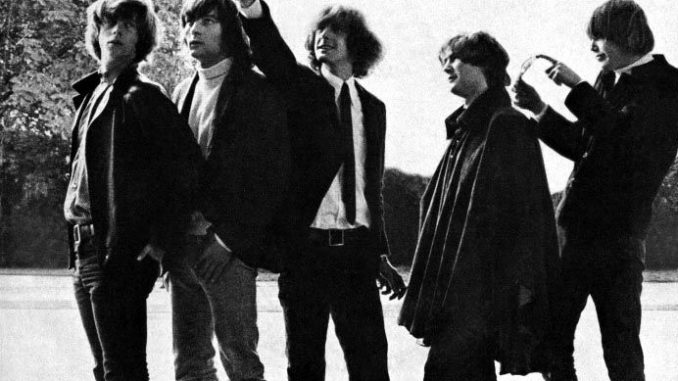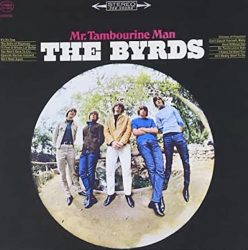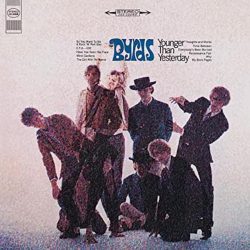
Our focus with this new feature is to look at the artists who have helped lay the foundations and pave the way for the emergence of the musical genre we know today as ‘americana’. Now there are clearly a number of acts deserving their place in this feature but I would like to turn the spotlight on a band who were responsible for creating, not one, not two, but three distinctly different styles all of which helped form the very structure of americana music, stretching its boundaries and guises to the myriad of sounds we’ve come to enjoy today. In doing so they created a legacy that I believe entitles them to be seen as the most important band in the history of americana music. Their name was The Byrds. Let me explain.
Nothing ever came from nothing, everyone was influenced or inspired by someone or something, and so it was with the founding members of The Byrds, Roger McGuinn (known as Jim until 1967) and Gene Clark, both coming from and having a modicum of success in the folk world, but both young and excited about this new high energy electric sound with pristine harmonies that was emanating from across the pond in the shape of The Beatles. David Crosby was similarly intoxicated with the new sound and attached himself to the duo bringing both a sound knowledge of jazz to the folk idiom but just as importantly, contacts. Crosby knew Jim Dickson who was a renowned producer of mainly bluegrass artists, but saw the potential for an ‘American Beatles’, and was able to supply both the studio time as well as help organise the finance to purchase the band’s electric equipment including a Rickenbacker guitar for McGuinn which would go on the be synonymous with both the band’s image and their songs with its chiming chords giving them their distinctive sound.
Whilst in rehearsal, Dickson played the band an acetate disc of the then unreleased Bob Dylan song, ‘Mr Tambourine Man’, and after a little arm twisting convinced them to record the track, but not before they changed the time signature. Dylan, invited to the studio by Dickson to hear this rendition was quoted as saying, “Wow man! You can dance to that”. The single would be released in January 1965 and by the March of that year Dylan would release, ‘Bringing It All Back Home’, his first to feature electric guitars. The influence he clearly had on the fledgling band had now been reciprocated, besides being the first to make Dylan a factor in pop / rock music they in themselves created a sound that continues to be a force in popular music today, and at the same time cementing a relationship that would go on to be one of the most symbiotic and synergistic in rock history.
The direction Dylan’s music would now take would continue to influence and inspire with his work with The Band becoming another focal point for the genre, while The Byrds, now a five piece with the addition of Chris Hillman and Michael Clark, would release their first two albums between June and December 1965. Both were full blown electric folk albums that drew on traditional songs, more Dylan tracks, along with self penned numbers, mostly from Gene Clark that would become classics in their own right, and whilst a tour of the UK, was shambolic and poorly received by the press it did allow them to meet and socialise with The Beatles who were vocal in their admiration, naming them their favourite American group. Many authors have suggested that not only were The Beatles admirers but they were also influenced, particularly on the 1965 album, ‘Rubber Soul’, where tracks such as, ‘Nowhere Man’, and, ‘If I needed Someone’. are obvious examples. The folk rock influence would spread along the from west coast to east coast of the U.S. and back across the Atlantic Ocean where bands, particularly, Fairport Convention would draw much inspiration for their debut album before forging their own path, weaving their electric instruments around the traditional music of the British Isles and becoming a major influence in their own right.

Over their first two album The Byrds proved themselves to be the supreme interpreters of Dylan’s songs, refining and refocusing the various stages and permutations of his writing, adding colour and depth so that they didn’t just cover but rather redefined and exposed their very folk and country roots and thus creating a launchpad to invent the genre of folk rock. To suggest they are solely responsible for creating the genre may be a mute point, however they are more responsible than any other act for melding the innovations and energy of the British Invasion with the best lyrical and musical elements of contemporary folk music. This on it’s own would guarantee them a place at americana’s top table, but this was just the beginning. Let us continue.
“If you can’t fly, you can’t be a Byrd!”. Despite the success of the first two albums all was not rosey in The Byrds camp. Gene Clark was by now recognised as the main songwriter within the band with such songs as, ‘She Don’t Care About Time’, and, ‘Set You Free This Time’, becoming instant classics, but that success and financial reward garnered jealousy within the band. Therefore when he announced that due to his fear of flying he would no longer board an aeroplane McGuinn wasted no time in delivering that legendary line. However before his departure Clark would contribute to one of the band’s best composition to date, ‘Eight Miles High’, and with it set them on a new musical direction.
By early 1966 the counter culture revolution that had been smouldering amongst the cafe’s and folk joints of L.A. along the west coast and over the pond to the streets of London was gaining pace. During this time Crosby seeing the departure of Clark as an opportunity to impose his influence on the bands musical path was forcibly introducing McGuinn to the music of John Coltrane and Ravi Shankar which would inspire McGuinn’s groundbreaking guitar playing on, ‘Eight Miles High’, combining free form jazz with Indian classical music which some in the music press would label, ‘raga rock’. All this combined with a pioneering spirit and lifestyle that stressed good times, good sex, and good drugs helped induce the birth of what came to be known as, ‘psychedelic rock’. Although their third album, ‘Fifth Dimension’, was not a complete success as the band struggled to regroup as a writing unit after the departure of Clark, it’s follow up at the start of 1967, ‘Younger Than Yesterday’, was much more positively received as it successfully combined psychedelia, folk and for the first time country music as Hillman started to flex his bluegrass muscles. This new sound struck a chord with a burgeoning youth at odds with their country’s involvement overseas, as well as a new wave of musicians from L.A. up to San Francisco that would embrace this new psychedelic sound. Acts such as Buffalo Springfield, Love, Jefferson Airplane and Grateful Dead all publicly named The Byrds as a primary influence, and would all go on to be major contributors and influencers of this new genre.
The influence wouldn’t be reserved for the west coast, as across in New York a whole new musical style was gaining traction of which one of it’s most important innovators, Lou Reed, would be quoted as saying of his band The Velvet Underground that, “the only west coast band we were influenced by was The Byrds”. A few years later New York’s punk priestess Patti Smith would record, ‘So You Want To Be A Rock ‘n’ Roll Star’, the opening track from, ‘Younger Than Yesterday’, and a shortly after Tom Petty and his Heartbreakers would unashamedly take the complete blueprint as a conduit for his own writing and become one of the most respected artists of the next forty years. While other acts from the seventies such as Big Star and Television were all influenced by this period of The Byrds.

By the turn of the 1980’s the band as a working unit had long since passed, however their musical impact was becoming stronger than ever with a whole host of indie and alternative rock acts citing and displaying their influence, especially from this period. The most successful of these was R.E.M. who’s guitarist Peter Buck’s guitar of choice was a Rickenbacker and freely admitted that his economical arpeggiated style was greatly influenced by McGuinn while the jangly guitar pattern and Gene Clark style vocals can easily be detected on songs by Echo and the Bunnymen. Johnny Marr of The Smiths was another disciple and by the end of the decade Manchester’s Stone Roses would also expose their musical debt on tracks such as, ‘I Want To Be Adored’, and, ‘She Bangs A Drum’. This influence on the indie and alternative scene would continue into the 1990’s where The La’s and their lead riff from, ‘There She Goes’, as well as such bands as Teenage Fanclub would continue to demonstrate the continued musical presence that The Byrds had over popular music. In fact it would be fair to say that only The Beatles could compete with this level of musical impact over so many different styles of music over such a period of time, which again, puts them in pole position when it comes to importance and influence on the full myriad of sounds that make up what is americana music. But the story doesn’t stop here, not by along way.
By the completion of the bands fifth album, ‘The Notorious Byrd Brothers’, Michael Clarke had quit and Crosby had been unceremoniously sacked by McGunn and Hillman for his continuous overbearing and egotistical behaviour, resulting in Gram Parsons and Kevin Kelley being drafted into the band, though purely on a salary basis. Hillman had been keen to direct the band in a more country direction having been seen as a respected mandolin player on the bluegrass scene prior to joining The Byrds and saw Parsons as the perfect conduit from his work with the little-known International Submarine Band, to help convince McGuinn in this new musical direction. Returning to the studio in March 1968 with the support of a stellar line up of session musicians, in particular Clarence White who had previously worked on two tracks from, ‘Younger Than Yesterday’, they set about producing the album that would become, ‘Sweetheart Of The Rodeo’. Now much credit is given to Parsons for the musical direction this album took and he clearly had is own agenda in where he saw the bands sound evolving to, but in truth only two of the tracks were written by Parsons whilst due to legal wrangling with his previous label his vocals contributions were limited to just three tracks.
On completion of the album the band flew to England to play at the Royal Albert hall before heading to South Africa for an ill advised tour, to which Parsons refused to travel and play in a racially segregated country, instead deciding to stay in West Sussex with his two new friends Mick Jagger and in particular Keith Richards. Parsons time as a Byrd amounted to less that five months and his departure predated the release of the album by eight weeks so his overall involvement could be challenged, however what isn’t in doubt is the influence he had on his newfound English friends and how dynamically the sound of The Stones changed after spending time in Parsons company that surely lends weight and testament to his contribution to the genre-defining album. By the time The Byrds returned from their disastrous tour of South Africa the album would be released and though in the main criticality well received the sales were the worst in the bands history. Rejected by the bands counterculture following who felt alienated by its content while at the same time eliciting hostility from the Nashville country music establishment, the album struggled initially to find an audience leading to Hillman to finally jump ship and join Parsons on his new project. McGuinn was now left as the sole original Byrd but by deciding to include White as a permanent member they embarked on a period that is often overlooked in the band’s history but would prove massively influential thanks to White’s revolutionary stringbender. Also known as a, ‘B Bender’, this was an innovation co-designed by Parsons that allowed White to duplicate the sound of a pedal steel guitar on his Fender Telecaster that would become a major influence on the sound of this new musical genre.

In time, ‘Sweetheart Of The Rodeo’, would go on to be recognised as the touchstone for, the new genre, and a seminal and highly influential album serving as a blueprint for the entire country rock movement, from the outlaw country of the 1970’s through to the alternative country genre of the late 1990’s and early 21st century. Bands such as The Flying Burrito Brothers, Poco, America and of course The Eagles can all trace their roots back to this album. By the early 1980’s a new sound emerged from L.A. known as, ‘The Paisley Underground’, with such acts as The Bangles and The Dream Syndicate being just two of the bands that were clearly indebted to The Byrds, while Stephen McCarthy’s guitar playing for The Long Ryders was greatly influenced by the country style of Clarence White. Their musical impact was still reverberating as clear as ever by the the late 1990’s where such alternative country giants like Wilco, openly displayed their inspiration, particularly on albums such as, ‘A.M’, ‘Being There’, and, ‘Summerteeth’, whilst The Jayhawks album ‘Tomorrow The Green Grass’, is littered with the chimes of The Byrds, especially on guitarist Gary Louris solo from, ‘Pray For Me’. All artist who have gone on to be influential in their own right, all directly influenced from the same band, like hundreds of tributaries all sprung from the same source.
So there we have it. Three separate musical genres, folk rock, psychedelic rock, and country rock, that all lie at the very foundation of what we recognise today as americana music, and all attributed to one act, and that’s without even touching on what the individual members achieved after their tenure with the band. However that’s for another day, and another feature, for now let us celebrate and doff our caps to the group of musicians who more than any others contributed to this music that we all feel so passionate about. Ladies and gentlemen I give you The Byrds.
https://www.youtube.com/watch?v=uSk5Afvz6jM



Graeme, Thanks for an insightful review that acknowledges the Byrds for their influence on generations of musicians, and their own great music. Got me searching through the closet for the Byrds box set.
Many thanks Michael for your kind words. Glad you enjoyed the article and pleased it’s inspired you to dig out your box set. Thoroughly enjoyed writing the feature and turning the focus on the bands massive influence on popular music over the last sixty years.
Thanks for this article, and I hope other “bedrock of Americana” artists will get featured. Just a quick question: Why do you say that The Byrds changed the time signature from Dylan’s original version? I would have thought both versions are 4/4.
Hi Mark, glad you enjoyed the article and thank you for your kind words. In relation to your question relating to the time signature, during my background reading for the article which included a number of, The Byrds, related books and articles I discovered that the acetate tape of the then unreleased Bob Dylan song, ‘Mr Tambourine Man’ was in fact a demo sung by Dylan and Ramblin’ Jack Elliott and recorded in 2/4 time. As you probably know when the track was recorded by the band only McGuinn actually contributed along with session men that included the ubiquitous Glen Campbell on guitar, Leon Russell on keyboards, Larry Knechtel on bass and Hal Blaine on drums. It was at this point the decision was made to change the time signature to a 4/4. Part of researching and writing articles such as this is discovering these sort of gems that I didn’t realise before either. Hope your happy with the answer.
What the author does not make clear is that there were two different Parsons. Gram was the vocalist, friend of the Rolling Stones, etc. But it was Gene Parsons, the drummer who replaced Michael Clarke, who invented the B-Bender for Clarence White.
Hi. To be honest it’s many months since I wrote that article so memory is a bit hazy, but yes, you’re absolutely right so apologies if I didn’t correctly give due credit.